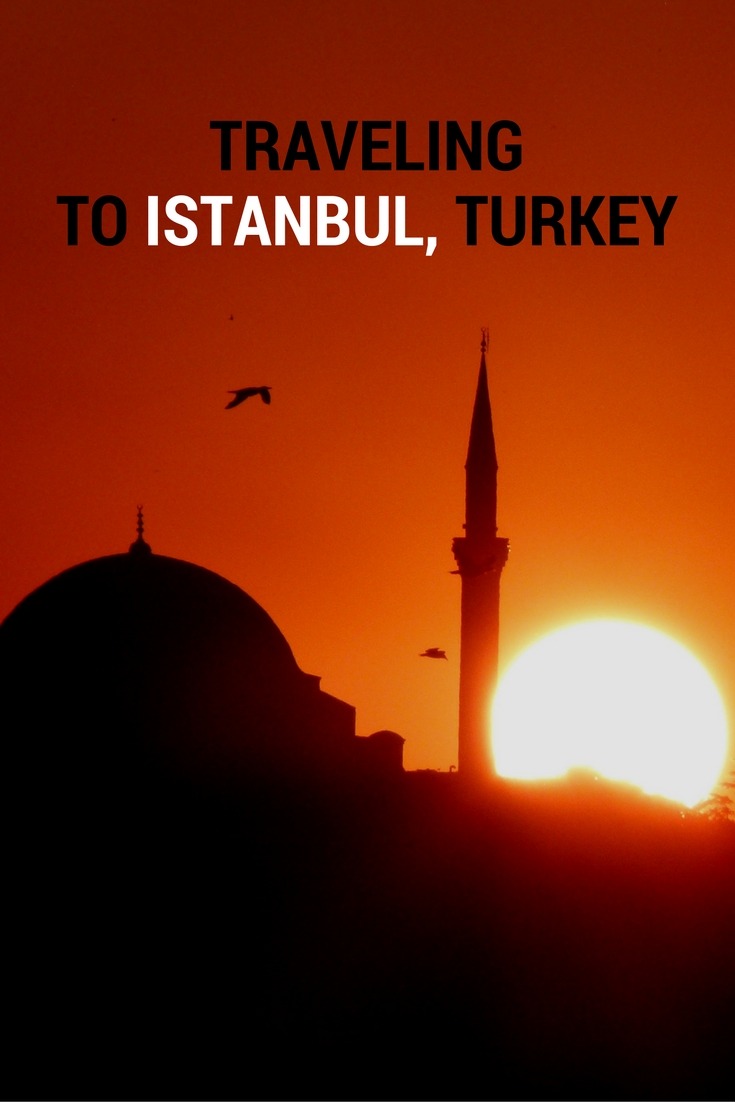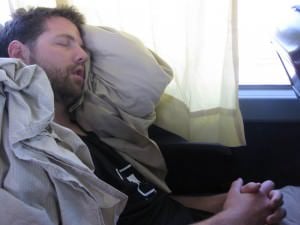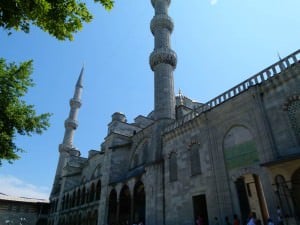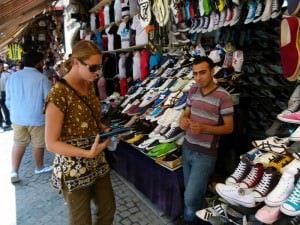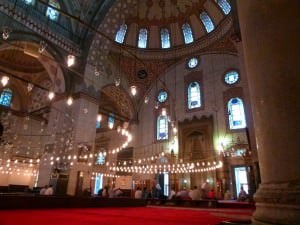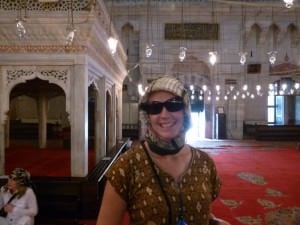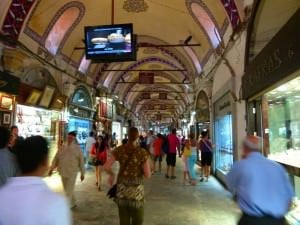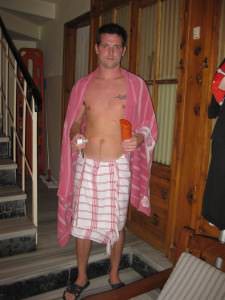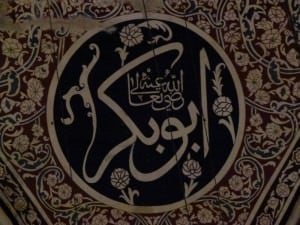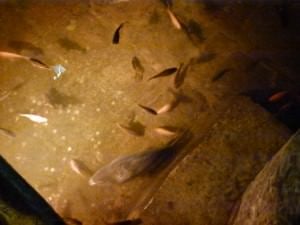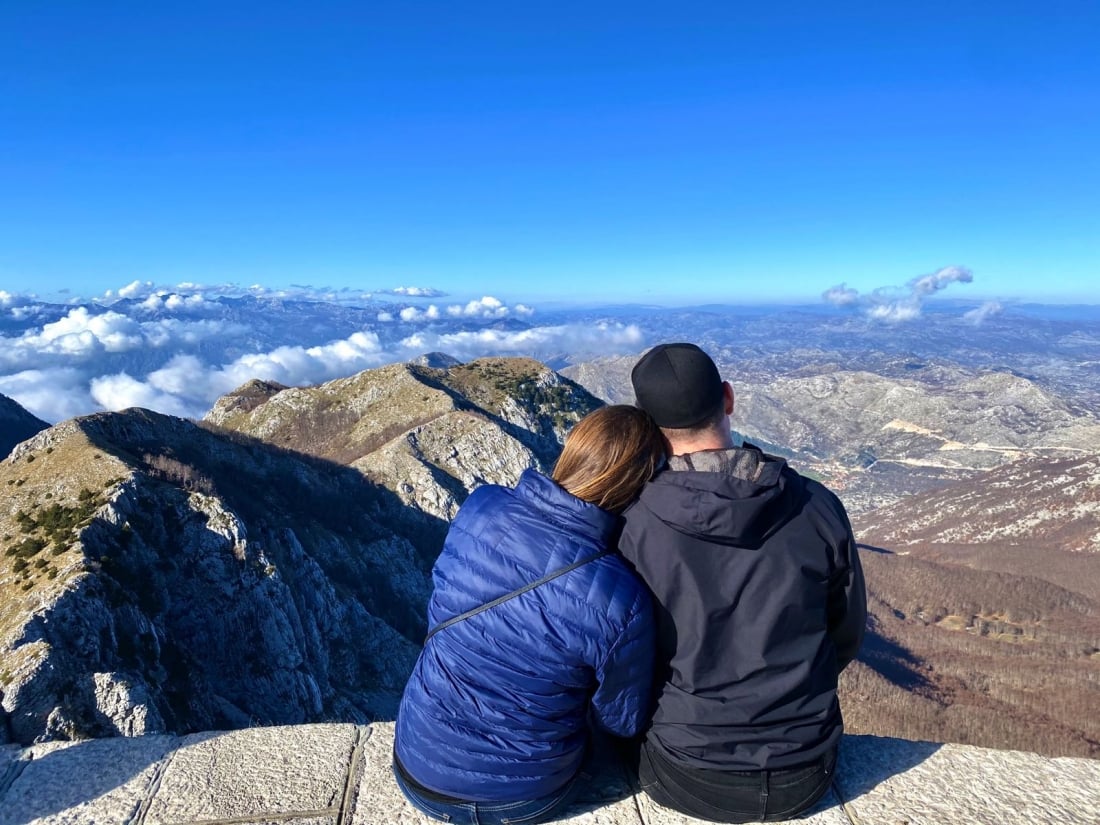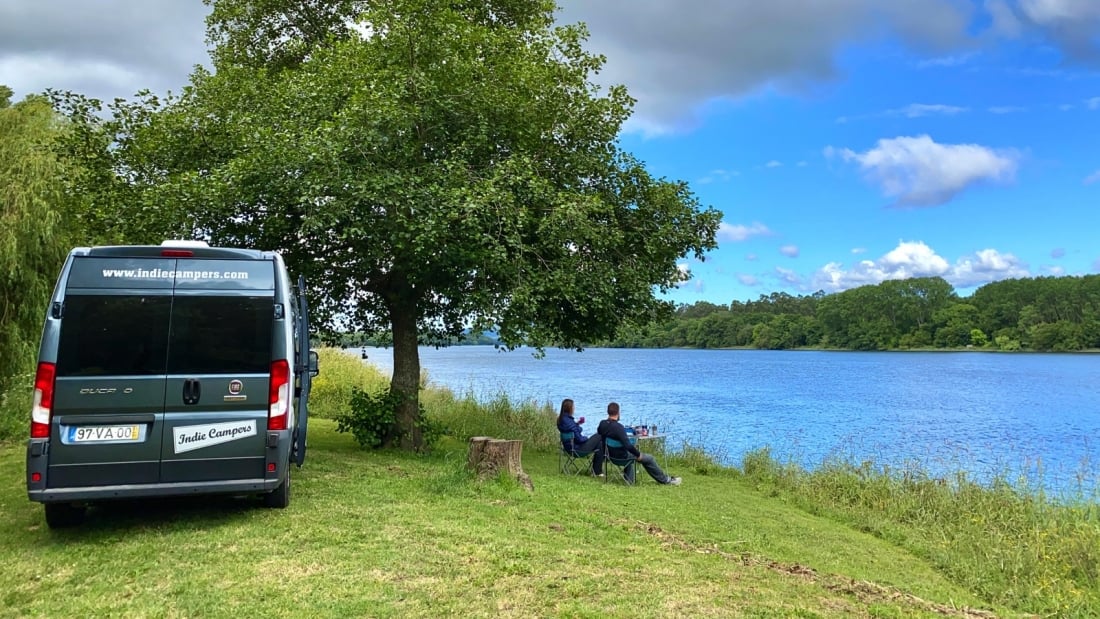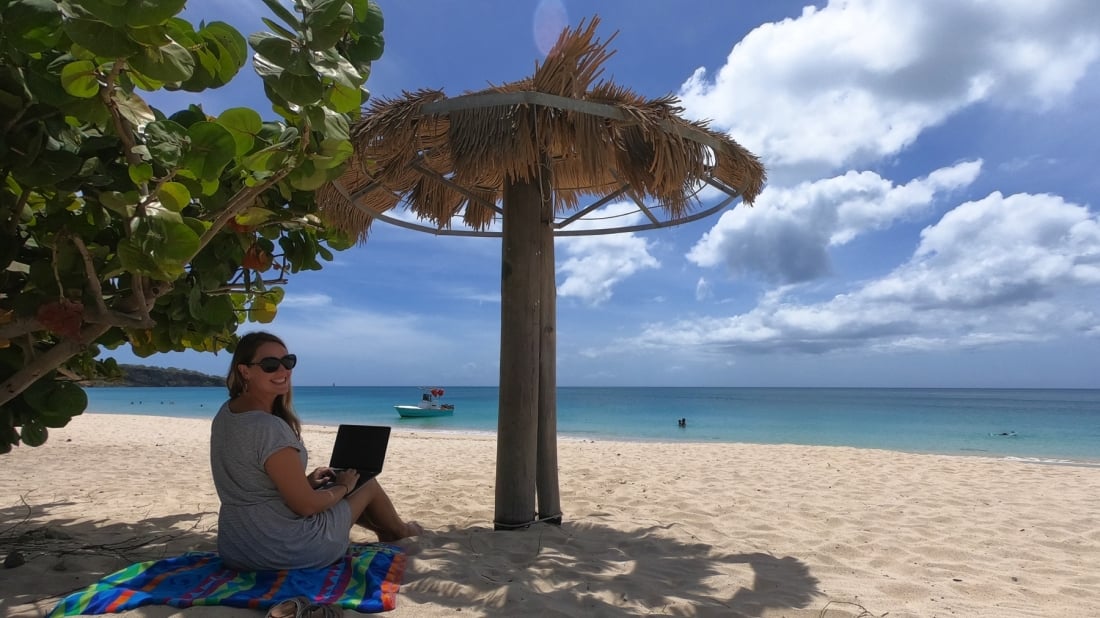We left Tbilisi, Georgia at 11:00 am on July, 5th and prepared ourselves for a gruelling 26 hour overnight bus ride to the Turkish Capital, Istanbul. Within the first 10 minutes, to our relief, the air conditioning started pumping and the long journey was actually very comfortable; as you can see by the flattering pass-out-pic Dariece sneaked of me shortly after leaving Tbilisi.
Arriving in Istanbul at around noon, local time, we were running off of about 4 hours of bus sleep and were feeling pretty beat, but immediately the energy of the thriving metropolis and its awesome sites woke us up. We caught the metro to our area of town “Sirceki” just outside the main tourist beat of “Sultanamet”. The metro drove right through Sultanamet on the way which is the heart of old Istanbul and full of jaw-dropping sites so we knew we wouldn’t be able to have a nap.
We dropped our bags off in our nice clean, bright, double room at Yeni Hostel, and headed out to Sultanamet. On the way we passed a ton of shops selling carpets, souvenirs, Turkish delights, clothing, and kebabs. Each one with its own, animated tout hollering the praise for his product on the sidewalk in front. The aptly named “old town” of Istanbul is stunning, especially for such a huge city and it retains much of its ancient beauty. The cobblestoned main street is a busy boardwalk of tourists and locals with the frequent tram buzzing through the middle. The road branches off into a spiderweb of tiny lanes with funky cafes and nargile (waterpipe) shops. As we neared Sultanamet the life of the city thumped louder with each step.
Shoe repair men kneeled on the ground plying their trade, music blared from all the stores, and the chatter of thousands of people was deafening. We walked into a gorgeous park with two of Istanbul’s most famous sites looming over head on either side. The huge Blue Mosque on one side, and the Massive 1500 year old Aya Sofia church, turned mosque, turned museum on the other. We decided to go into the Blue Mosque and check it out, for once admission was free and Dariece was even told she didn’t have to cover her head, but she did anyway. The inside was huge and we just sat on the floor in awe of the incredible architecture.
On the second day in Istanbul we got up and had breakfast at the restaurant next to our hotel named Can. The owner, Chanan, was super nice and the food was delicious and we have gone there every morning now in Istanbul so we just walk in and he says “Hi Nick & D! Same as usual?”
I get sausage and egg skillet and Dariece gets a cheese omelette. It’s nice to have a little routine in our lives sometimes. After breakfast we headed out to the Grand Bazaar. A huge bazaar (market) district that stretches, completely covered, for kilometers in each direction. It was so big and there was so much stuff, that even on our tight budget we walked out after about 3 hours with our hands full of bags. We bought one big souvenir that seemed appropriate for all of the Middle East, a sheesha pipe (nargile), and a few things we needed for our bags. The bazaar was completely overwhelming although the shop owners were surprisingly stand-offish in comparison to most bazaars we have seen.
After the market our feet and legs were aching from so many days of constantly walking around Tbilisi, sitting on a bus for 26 hours, then walking around Istanbul and the market. We needed special treatment, so we headed to an age old Turkey remedy, the Hammam (Turkish Bath). The Hammam we chose was the 427 year old Cemberalitas Hammami downtown. The entire building is made out of marble and as we walked in the thick smell of steamy water and herbal soap filled the air.
Dariece and I chose the Traditional Experience for around $30 which included a scrub, short massage and as much bath time as we wanted. Dariece and I had slightly different experiences in the Hammam because it was separate bathing areas for men and women but the basics are the same and we both loved it. For me, I was rushed along upstairs to the change rooms by impatient, towel clad attendants and told to change into nothing but a small towel or “pestamal”.
As I entered the massive, steamy, circular marble room, I barely had time to marvel at the ancient surroundings before I was hustled onto the huge slab of hot marble at the center along with about 15 other men both local and foreign. Before I could ask questions like “how does this work?” or “where do I go?” a big, burly, hairy, Turkish man pushed me flat on the hot slab and poured a bucket of hot water on me.
He then took the soap from my hand (a special gritty soap provided by reception), dawned his scrubbing mitten, and started vigorously scrubbing me from head to toe, leaving barely enough unscrubbed to be appropriate. He flipped me over and scrubbed my back as well, pushing so hard that my reddened skin stung with each stroke.
He then sat me upright and scrubbed my chest and under my arms. After his relentless pulling and prodding was finished he pointed to my skin and when I looked down I saw that it was covered in balled up, black dirt and dead skin. He then hastily poured steaming hot water all over me so that the dead layers of skin disappeared into the hidden drainage below the marble slab.
He laid me down again to cover me in a thick blanket of moisturizing bubbles. He then proceeded to give me an amazing massage that truly hurt my aching muscles but felt extremely invigorating. When he was done that he took me to a separate room and poured more buckets of hot water over my head and shampooed my hair with a nice head massage before saying “my name Chan, thank you bye”.
I stood and re-entered the giant main room of the hammam and found a private separate marble room where I sat and relaxed in the steaming heat, enjoying the echoed ambiance inside the rock walls that have seen millions of men over the last 5 centuries. I laid on my back and looked up at the honey combed ceiling which was speared with sunlight from outside and I pondered just how much dead skin, dirt and scum these beautiful marble rooms have seen.
The place was immaculately clean but I would imagine it takes hours of scrubbing every day for the last 427 years to keep it that way. The marble steps and seats were deeply dented in spots, clearly displaying areas of high traffic worn down and scarred over the years. After nearly an hour and a half in the Hammam, Dariece and I met in the lobby with invigorated and relaxed smiles across our faces. It was truly an amazing experience that I will never forget, and I have NEVER felt so clean in my life. Needless to say we slept great that night.
The next day we got up around 9:30 and headed over to the Baslica, a huge, ancient, underground river system built by the Byzantines in 522 AD. The Baslica once held 80,000 cubic meters of water and distributed it around the ancient kingdom through 20 km of aqua ducts that even stretched under some homes so that owners of the homes could lower a bucket to retrieve water and even fish from their basements. The huge, eerie underground room contains 336 massive columns, some of which are beautifully carved, and lurking in the water are thousands of huge, ghost like carp.
After the Baslica we headed for the waters edge, near Galata Bridge, where we sampled some of Istanbul’s famous fish sandwiches. The line up was huge but only took us a few minutes to get to the front, thanks to the handiwork and superhuman speed of the experienced sandwich peddlers who could put the meal together in a flurry of flipping and stuffing before we had time to pay. The sandwich was good but full of bones and fins so it won’t make return customers out of us, but the experience was worth it all.
The area of Istanbul that rims the Golden Horn which enters the Marmaris Sea is alive with activity. Men fishing on every open inch of the railings to the sea, boatmen selling trips up the Bospherous canal, orange juice salesmen, and strolling locals all set on the backdrop of old Istanbul and its towering mosques and historic buildings.
We headed over to the Galatas Bridge which is used as much for traffic as it is for fishermen who dangle their lines some 50 feet to the ocean below. Below the bridge is lined with cafes, bars, and restaurants literally right on the water. We took up a good spot with a view of the huge ships and cargo boats inside one of the bars and ordered a couple beers.
This is the life. Looking out at the sea, which is only 10 feet in front and 2 feet below us, drinking a beer and watching the hundred or so lines reeling in hundreds of small fish to the fishermen on the bridge some 20 feet above us. We watched the sun go down on the sea and listened to the chorus of mosques sing there final call to prayers of the day before heading home. Another great end to another great day in Istanbul.
On day 4 in the incredible city of Istanbul we started our day off as we did every morning, in Can’s restaurant for breakfast and chai, and then headed out to see Aya Sofya, the huge Church turned Mosque turned Museum. Luckily we got up at around 8:00 to get there early and avoid the crush of crowds that descend on Aya Sofia every day. There were still a lot of people there, but the enormous 1500 year old structure seemed almost deserted even with the hundred or so people already inside.
It was completed in AD537 and remains, to this day, the most famous structure in Istanbul, a city littered with historical gems. It was originally built by Justinian to restore the glory of the Roman empire, and it stood for nearly a thousand years as the greatest church in the world, until in 1453, Mehmet the Conqueror, converted it into a mosque. The mosaics and paintings depicting Jesus, Mary, Gabriel and other Biblical portraits stayed even after the conversion, perhaps even Mehmet was awed by their beauty.
A few hundred years later it was made a museum and so it has stayed until present day. When we first arrived, we walked through a huge outer garden and in through the towering main doors to the main area and the shear size of the massive room and the detail and beauty of its walls is another site indescribable with words on a blog.
The massive, mosaic ordained dome at the center is so high, and the huge pillared walls on either side are so far apart, that the building seems to go on forever. We walked around for nearly 2 hours pointing at and photographing different portraits and gold markings all around the Museum but none of our pictures do this architectural masterpiece any justice. Every mosque we have ever seen has been stunning but Aya Sofya most definitely takes the cake.
Later on that day we headed across the Galata Bridge via Tramway and entered Beyoglu in the “New Istanbul”. The wide cobblestone boardwalk is fringed with all the top brand name shops, trendy cafes, funky bars, and even Starbucks! We couldn’t resist. 2 venti extra hot caramel macciattos please!
We basically just walked up and down the street and took in the incredible ambiance. An entire orchestra took up the old trolley that still runs down the center of the street, and they stopped and played song after song while the locals danced around. There was magicians, pirates, singers, and clowns all accompanied by the regular salesmen screaming their songs to the passing pedestrians.
We were planning to go to a Meyhane, or local bar district in a network of narrow alleys, but we spent so much time enjoying the buzzing atmosphere of the streets that by the time we arrived, 9:00 on a Friday night, all the tables were full and the places were all packed. We had dinner just outside the district at a nice little restaurant and it was a relief to get off of our feet. I don’t know how many kilometers we put on every day but we can definitely feel the burn, especially if we’re wearing frip frops.
On our last day in Istanbul we were feeling a little tired, but we got up and said our goodbyes to Chanan at our breakfast restaurant because he’s closed Sundays so we wouldn’t see him before we fly out. Then we went for a stroll through the gardens around the massive walled palace in Sultanamet.
The trees were so green and there were flowers everywhere. The locals were stretched out in groups all over having picnics on big blankets or just napping in the shade under the trees. We returned to our room around two in the afternoon and spent most of the day studying our new Southern Africa Lonely Planet guide book because today we fly to Cape Town South Africa!!!
That’s right, no more past tense. We’re actually currently caught up on the blogs so we are currently writing this blog from the lobby in our hotel room at 2:30 on July, 10th 2011 and we are flying out in 5 hours. We’re leaving Turkey in the middle of summer, with the longest days and the hottest weather of the year, and heading to South Africa in the southern hemisphere and thus in the winter, with the shortest days and coolest weather.
Which is actually quite cold, in the Highveld the temperature is likely to drop below zero at night but the majority of the country will be nice and warm. In Cape Town we’re looking at about 18-20 degrees day time temperature so it should be nice. Not only will it be a culture shock, but a climate shock as well.
We’ve become used to Turkey’s 30-40 degree weather. But we’ve been looking forward to South Africa for a long time. We have a car rented for 5 weeks and we pick it up in the airport when we land. We’ll be touring the country for nearly a month and a half and taking in its world renowned sights and coastal drives along the way. Penguins, wineries, soccer games, lions, elephants, giraffes, hippos, seals, mountains, safaris, hikes, and who knows what else. South Africa HERE WE COME!
Like this Post? Pin it!

